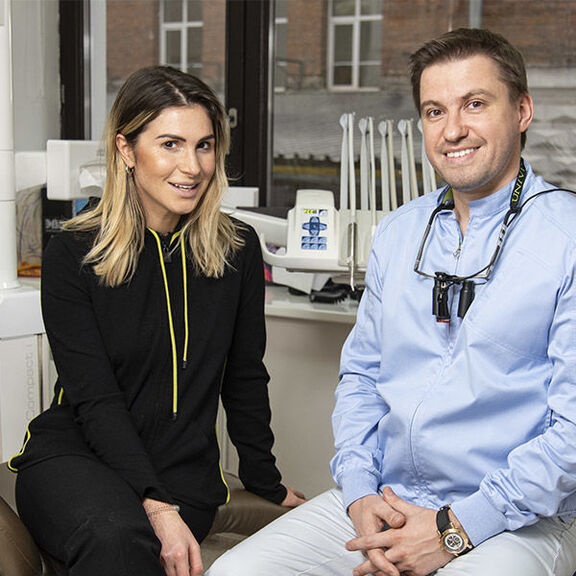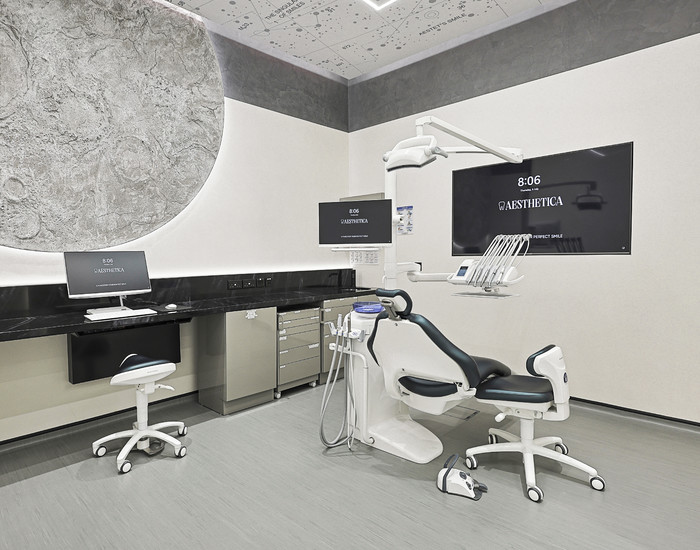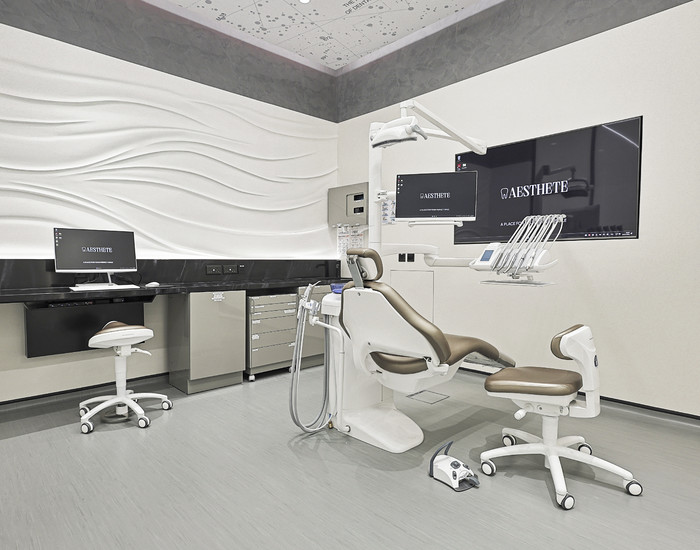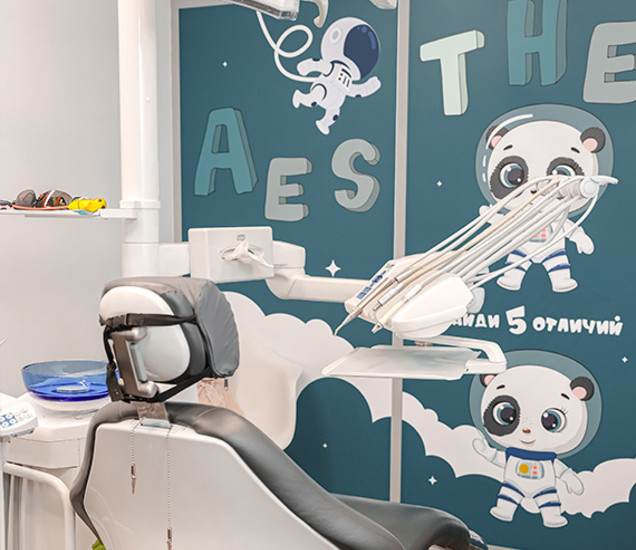Tooth cysts occur as a result of the body's defensive reaction to infection or trauma. If the immune system is functioning normally, it usually poses no danger. However, if immunity is weakened, the disease can enter an acute phase. Without treatment, you could lose not only the tooth but also face more severe health consequences. AESTHETE Dental Clinic offers services for treating tooth cysts.
How we can be
useful to you:
Veneers Without Grinding
Pediatric dentistry
Correction of bite
Implantation and crowns
What is a Cyst and Why Does It Occur?
When pathogenic microorganisms penetrate the jawbone tissue, inflammation can begin. The affected cells die, and a cavity forms near the root of the tooth. Around it, a capsule with dense walls forms to prevent the inflammation from spreading further. Inside the capsule are dead cells and their decomposition products, bacteria, and inflammatory fluid. Its size ranges from a few millimeters to several centimeters. In the early stages, while the growth is still small, it is called a granuloma. As it grows, it becomes a cystogranuloma and then a cyst. The most common causes of cyst formation are:
- Untreated caries;
- Pulpitis, periodontitis, periodontal disease;
- Errors in root canal treatment;
- Trauma;
- Overloading individual teeth due to irrational prosthetics;
- Developmental pathologies of the upper or lower jaw;
- Infectious diseases of the oral cavity and nasopharynx.
Types of Tooth Cysts
Granulomas or cystogranulomas are not considered full-fledged cysts because a pus-filled capsule has not yet formed. Fully developed cysts of this type are classified by their cause and mode of occurrence. Based on these criteria, the following types of cysts are distinguished:
- Root cyst: a classic variant, develops due to inflammation and death of the internal tooth tissues, located at the upper third of the tooth root;
- Residual cyst: may arise as a reaction to improper tooth treatment or if a fragment of the tooth remains in the socket after extraction;
- Follicular cyst: develops from a follicular sac that covers an unerupted tooth, characterized by especially high growth rates;
- Eruption cyst: occurs during slow tooth eruption;
- Lateral periodontal and calcifying odontogenic cysts: the exact causes of their occurrence are unknown.
Symptoms of a Tooth Cyst
In the early stages, a granuloma or cyst does not manifest any symptoms. This complicates treatment because by the time the doctor discovers the growth, it may already be large and removable only by surgery. The primary symptom is pain when biting with the affected tooth or pressing on the gum where the cyst is located. Pain may increase and decrease depending on the immune system's state. As the cyst grows, it may cause visible bulging of the bone tissue or a fistula on the gum near the affected tooth's root. Other signs include:
- Acute pain when immunity decreases, hypothermia, infectious diseases, or as a reaction to exacerbation of chronic diseases or certain medications; the pain usually intensifies during chewing;
- Swelling of the face in the area of the cyst localization;
- Elevated body temperature;
- Enlarged lymph nodes;
- General malaise, weakness, headache.
Importance of Timely Diagnosis
In the initial stages, a granuloma or cyst is unnoticeable and does not manifest any symptoms. Therefore, the person may not realize a potentially dangerous growth is developing at the tooth root. By the time symptoms are felt, the tooth may be severely affected and need extraction. The tissues around the tooth root may be severely damaged, complicating implant placement and requiring additional treatments like osteoplasty to increase bone tissue volume. Timely diagnosis can detect a cyst at an early stage. Radiography can locate and determine its size. Therefore, it is advisable to visit a dentist twice a year for a preventive check-up. The dentist can identify signs of diseases at stages when they are easily treatable, increasing the likelihood of preserving teeth.
Cyst Removal Treatment
-
Title
Price
-
Cyst Removal Treatment
from 3190 AED
More Dental Services
Dangers of Cystic Growths
A cyst will not disappear on its own and must be treated. Otherwise, it will continue to grow, destroy tooth roots, and affect the surrounding soft and hard tissues. It can spread to several teeth. Without timely therapeutic treatment or cyst removal, it may turn into a malignant growth. Possible complications include:
- Severe purulent inflammation of the gum;
- General health problems that degrade quality of life: persistent weakness, malaise, frequent headaches, swelling in the cheek area near the affected site;
- Destruction of tooth roots, leading to tooth loss;
- Osteomyelitis, which destroys jawbone tissues. Osteomyelitis can adversely affect surrounding tissues, potentially leading to eye damage and vision loss. Another possible complication is pus entering the bloodstream, causing sepsis, which is life-threatening.
Conservative Treatment
The success of cyst treatment largely depends on the stage at which it is detected. Modern dentistry employs methods that can avoid tooth extraction, but they are mostly effective in the early stages when the growth is relatively small. A common therapeutic procedure involves:
- Drilling and cleaning the affected root canals;
- Injecting antibiotics and agents that destroy the cyst capsule;
- Filling the cavity with a special paste that stimulates bone tissue regeneration;
- Sealing. Several sessions with temporary fillings are usually required, with the dentist constantly monitoring the result using radiography. The method's effectiveness is 75%. An alternative method that avoids surgery and drilling is depophoresis, where the dentist combines the effect of electric current with copper-calcium hydroxide introduced into the root canal. Conservative methods are used if the affected area is not very large and the chances of saving the tooth are high. Otherwise, treatment will be ineffective and the situation will worsen.
To make you healthy,
happy and successful!
will help you with this
When Surgical Treatment is Necessary
The decision for surgical intervention is based on the clinical picture and the patient's individual features. Surgery is usually performed if the growth size is 8-10 mm. Modern techniques often allow cyst removal while preserving the tooth, but in some cases, this is not possible. Common indications for tooth extraction include the root being submerged in the cyst cavity by more than half its length or significant destruction. This situation can occur if the patient delays visiting the dentist.
Preparation for Cyst Removal
Cyst removal is conducted after thorough diagnosis. It is essential to determine the growth's location and size, understand the tooth-jaw system's characteristics, and assess the patient's condition to choose an appropriate treatment method. Diagnosis includes examination, radiography, and orthopantomogram (a panoramic jaw image). Additional methods may include:
- Percussion: tapping on the tooth crown to assess the periodontal condition;
- Electroodontodiagnostics: evaluating the pulp's condition, the soft internal tooth tissue containing blood vessels and nerve endings. If the patient has caries, pulpitis, or other dental diseases, they must be treated first. Professional cleaning may be necessary to thoroughly remove soft plaque and hard deposits.
Cyst Removal Procedures
If conservative methods are ineffective or the cyst size is 8-10 mm or more, surgery is required. There are several surgical methods, allowing the dentist to choose the best option for the specific case. Local anesthesia is used regardless of the chosen method.
Cystectomy
This method is indicated for removing small cysts or large growths where no teeth are present. The surgeon:
- Separates the soft tissues;
- Drills a hole at the root projection;
- Removes the root tip;
- Excises the cyst capsule with its contents;
- Seals the root canals;
- Sutures the mucoperiosteal flap to the mucosa. If the cyst was large, creating a significant cavity, the dentist fills it with osteoplastic material to promote bone tissue formation. Cystectomy duration ranges from 40 minutes to 1.5 hours, depending on the intervention's scope.
Cystotomy
This method is used to remove large cysts. The dentist:
- Excises the mucoperiosteal flap, separates the soft tissues, and exposes the bone;
- Drills a hole to allow fluid to exit;
- Removes the cyst's front wall;
- Rinses and disinfects the cavity, places an iodine-soaked tampon. The tampon is replaced after a week, and a third one may be placed if necessary. Cystotomy is minimally traumatic, and patients tolerate it well. Complete treatment with tampon replacement takes several weeks.
Hemisection
This surgery is performed on multi-rooted teeth, allowing partial preservation of the tooth, which can later serve as a support for an orthopedic prosthesis or be restored with composite material. The dentist amputates the root along with the affected segment. If necessary, the cavity is filled with osteoplastic material.
AESTHETE Dental Clinic is located in Dubai (UAE), Bluewaters Island. If you have a diagnosed cyst, contact our medical center. We treat patients of all ages using therapeutic and surgical methods tailored to the specific condition. If you have questions, the clinic administrators will answer them. They will help you choose a time to visit the dentist, specify the address, and explain how to schedule a consultation.
Evaluate the amazing
results of our clients:
FAQ
The following types of dental cysts are distinguished:
- Follicular, forming from the follicle of a tooth that did not erupt on time;
- Radicular (also called periapical), forming due to an inflammatory process and located at the upper area of the tooth root or its lateral parts;
- Keratocyst, appearing due to abnormal development of the tooth germ;
- Residual, arising after tooth extraction if remnants of its root remain in the socket.
A small cyst may not give any signs. But as the neoplasm grows, the following symptoms occur:
- Dull pain;
- A feeling of pressure or tightness;
- Swelling, noticeable puffiness;
- Looseness or mobility of the tooth;
- Foul odor coming from the mouth;
- Malaise, weakness;
- Elevated body temperature.
Literature sources
- Aliaa, A. A.; Youssif, Abeer Saad; Gawish, Mohammed Elesaid; Moussa, [без инициалов?]. Automated Periodontal Diseases Classification System. (IJACSA) International Journal of Advanced Computer Science and Applications , Vol. 3, No. 1, 2012.
- Higuera, V.. Dentigerous Cyst. Healthline , 2018.
- Browne, R.. The odontogenic keratocyst. Clinical aspects. British Dental Journal , 1970, 128, 225–231.
- Caruso, D. P.; Lee, C. C.; Peacock, Z. S.. What factors differentiate dentigerous cysts from other pericoronal lesions?.
Our clinics:
Clinic in Dubai
Resident part, Building 10
Clinic in Moscow
metro Chistye prudy
Clinic in Moscow (Barvikha)
Shopping center "Dream House" 3rd floor
















































_700x550_ac7.jpg)






